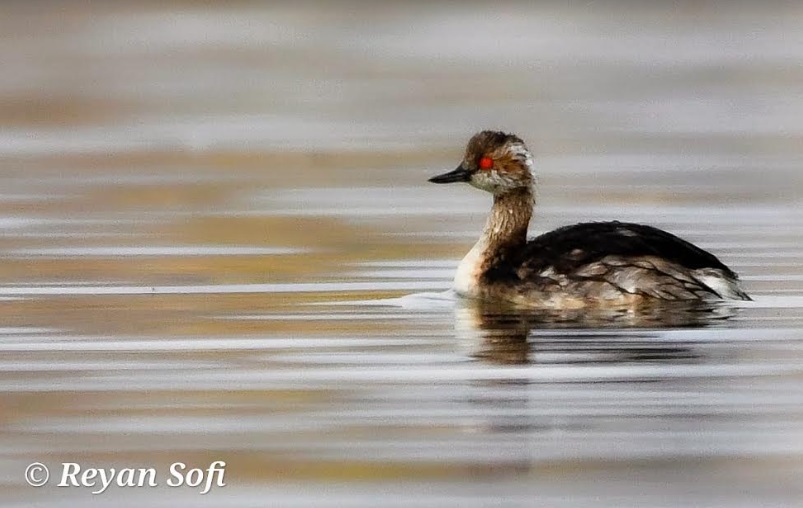
Srinagar- In a notable development for Kashmir’s avian landscape, a novel bird species, Black-necked Grebe has been spotted for the first time among the migratory flocks at Hokersar Wetland. This find, which has thrilled birdwatchers and conservationists, comes amidst ongoing efforts to restore the wetlands.
Captured through the lens of avid bird photographer Reyan Sofi, the discovery has been successfully added to eBird – an online database of bird observations that provides real-time data about bird distribution and abundance.
Black-necked Grebe is a small, gregarious species with a wide distribution, ranging from Europe through Asia. During winter, it can be found in the south-western Palearctic, east Asia, and east Africa.
The species has been identified breeding in various locations, including southern Africa, south-west Canada, western USA, and central Mexico. Locally, it is found across a broad range from the British Isles to West Siberia, extending southward to Morocco, Iraq, Afghanistan, and eastward to India and Pakistan.
In India, reports indicate its breeding presence in the Union Territory of Ladakh. During winters, the species migrates to the western Gangetic Plains, Gujarat, and central Nepal. Occasionally, it strays eastward to the eastern Assam Valley and Bangladesh, and southward to coastal Orissa and Pune, Maharashtra. The recent sighting in Jammu and Kashmir adds to its expanding range.
According to Reyan Sofi, there were reports of sightings of Black-necked Grebe in the month of March this year. However, the same was not confirmed.
“Our observation is believed to be the initial verified record from Jammu and Kashmir. The bird was in basic plumage and identified based on a bright red iris, black top of the head and mantle, neck black on the back and grey on the front, white breast, rump, and belly,” he added.
Using his expertise and passion for capturing migratory birds, Reyan Sofi has managed to document other rare avian visitors in the past too. Last year in February, he spotted a Falcated duck in Hokersar wetland and a Black-bellied Plover in Wular Lake.
Sofi said that they have spotted over 200 new species of birds in the Hokersar wetland so far.
Last year, field officials of the Wular Conservation and Management Authority (WUCMA) spotted a long-tailed duck (Clangula hyemalis), a rare duck species, after a gap of 84 years.
As winter sets in, thousands of birds from various parts of the world migrate to Kashmir, seeking refuge from freezing temperatures in their summer habitats in Central Asia and Russia, where food becomes scarce. These birds can be seenin numerous wetlands across Kashmir, including Hygam, Pampore, Badi Nambal, Shallabugh, Anchar, Dal Lake, Wular Lake, Chatlum, Kranchoo, Manibugh, Freshkhoori, Hokersar, and Mirgund.
The birds include teal, common pochard, merganser, northern shoveler, northern pintail, Eurasian wigeon, red-crested pochard, tufted duck, sheldrake duck, mallard, coot, gadwall, Brahminy duck, cormorant, Greylag goose.
Wildlife warden, wetlands, Ifshan Dewan told Kashmir Observer that over 5-6 lakh migratory birds have visited Hokersar wetland so far. She said the conditions of the wetlands are in ‘good position’ and the migratory birds are arriving in large numbers.
“Whatever management interventions we had to do, we completed it. The condition of the wetlands is very good as of now,” she said. The department, she said, has plugged breaches and the water master is presently working in the wetland to create more channels.
The wetlands in the valley are under tremendous stress due to continuous human intervention including land grabbing, poaching, construction and pollution which have significantly altered the nature of these areas. Consequently, migratory birds face considerable challenges in locating suitable habitats within this Himalayan region.
According to a report from National Institute of Disaster Management (NIDM), the wetland has receded consistently and undergone tremendous land-use change owing to siltation coupled with floods and human interference.
“The Hokersar wetland has experienced fragmentation and changes in land use/land cover due to excessive siltation and biotic interference over the last four decades,” the report said. The study noted that most of the developmental activities are usually undertaken with utter disregard to environmental, geological, geomorphological and ecological conditions of the region.
However, officials have asserted that they are actively pursuing multiple projects aimed at the restoration of the wetlands, and the work is currently in progress.
Notably, this year the Union territory administration undertook a mega project to rejuvenate Hokersar Wetlands, one of the eight Ramsar sites in the valley. With a focus on transforming the wetland into an ecotourism destination, authorities aim to leverage its appeal to attract a multitude of migratory birds. The government is also working on restoration of Wular lake in North Kashmir’s Bandipora district.
Follow this link to join our WhatsApp group: Join Now
Be Part of Quality Journalism |
Quality journalism takes a lot of time, money and hard work to produce and despite all the hardships we still do it. Our reporters and editors are working overtime in Kashmir and beyond to cover what you care about, break big stories, and expose injustices that can change lives. Today more people are reading Kashmir Observer than ever, but only a handful are paying while advertising revenues are falling fast. |
| ACT NOW |
| MONTHLY | Rs 100 | |
| YEARLY | Rs 1000 | |
| LIFETIME | Rs 10000 | |










